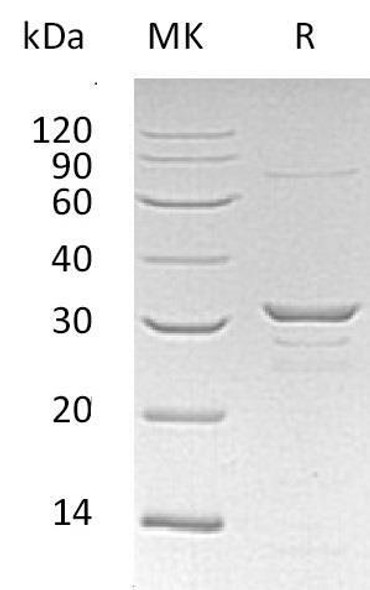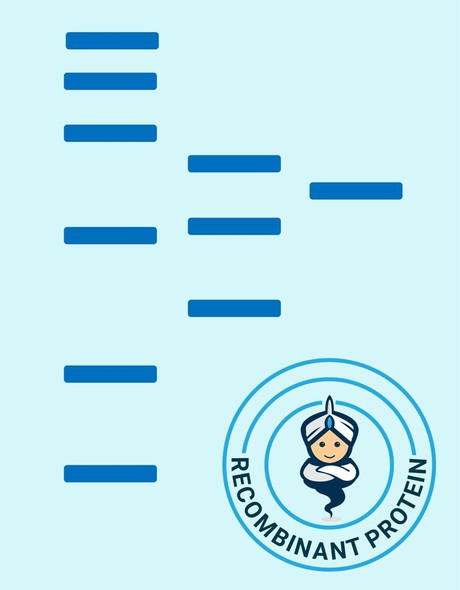Description
| Product Name: | Human CLIC1 Recombinant Protein |
| Product Code: | RPPB3202 |
| Size: | 25µg |
| Species: | Human |
| Target: | CLIC1 |
| Synonyms: | ACBP, ACBD1, CCK-RP, EP, CLIC1, G6, NCC27, Nuclear chloride ion channel 27, Chloride channel ABP, Regulatory nuclear chloride ion channel protein, hRNCC, Chloride intracellular channel protein 1. |
| Source: | Escherichia Coli |
| Physical Appearance: | Sterile filtered colorless solution. |
| Formulation: | CLIC1 Human solution containing 20mM Tris-HCl pH-8, 0.1M NaCl & 10% glycerol. |
| Stability: | Store at 4°C if entire vial will be used within 2-4 weeks. Store, frozen at -20°C for longer periods of time. For long term storage it is recommended to add a carrier protein (0.1% HSA or BSA).Avoid multiple freeze-thaw cycles. |
| Purity: | Greater than 90% as determined by SDS-PAGE. |
| Amino Acid Sequence: | GSSHHHHHH SSGLVPRGSH MAEEQPQVEL FVKAGSDGAK IGNCPFSQRL FMVLWLKGVT FNVTTVDTKR RTETVQKLCP GGQLPFLLYG TEVHTDTNKI EEFLEAVLCP PRYPKLAALN PESNTAGLDI FAKFSAYIKN SNPALNDNLE KGLLKALKVL DNYLTSPLPE EVDETSAEDE GVSQRKFLDG NELTLADCNL LPKLHIVQVV CKKYRGFTIP EAFRGVHRYL SNAYAREEFA STCPDDEEIE LAYEQVAKAL K |
Chloride channels are various group of proteins that control fundamental cellular processes including stabilization of cell membrane potential, transepithelial transport, regulation of intracellular pH, and maintenance of cell volume. CLIC1 is part of the p64 family and is localized to the cell nucleus. CLIC1 displays both nuclear and plasma membrane chloride ion channel activity. CLIC1 inserts into membranes and forms chloride ion channels. CLIC1 channel activity depends on the pH. CLIC1 membrane insertion is redox-regulated and happens under oxydizing conditions.
CLIC1 Human Recombinant produced in E.Coli is a single, non-glycosylated,polypeptide chain containing 261amino acids (1-241a.a.) and having a molecular mass of 29 kDa. CLIC1 protein is fused to a 20 amino acid His tag at N-terminus and is purified by standard chromatography.
| UniProt Protein Function: | Can insert into membranes and form chloride ion channels. Channel activity depends on the pH. Membrane insertion seems to be redox-regulated and may occur only under oxydizing conditions. Involved in regulation of the cell cycle. |
| NCBI Summary: | Chloride channels are a diverse group of proteins that regulate fundamental cellular processes including stabilization of cell membrane potential, transepithelial transport, maintenance of intracellular pH, and regulation of cell volume. Chloride intracellular channel 1 is a member of the p64 family; the protein localizes principally to the cell nucleus and exhibits both nuclear and plasma membrane chloride ion channel activity. [provided by RefSeq, Jul 2008] |
| UniProt Code: | O00299 |
| NCBI GenInfo Identifier: | 12643390 |
| NCBI Gene ID: | 1192 |
| NCBI Accession: | O00299.4 |
| UniProt Secondary Accession: | O00299,Q15089, Q502X1, |
| UniProt Related Accession: | O00299 |
| Molecular Weight: | 26,923 Da |
| NCBI Full Name: | Chloride intracellular channel protein 1 |
| NCBI Synonym Full Names: | chloride intracellular channel 1 |
| NCBI Official Symbol: | CLIC1�� |
| NCBI Official Synonym Symbols: | G6; NCC27�� |
| NCBI Protein Information: | chloride intracellular channel protein 1 |
| UniProt Protein Name: | Chloride intracellular channel protein 1 |
| UniProt Synonym Protein Names: | Chloride channel ABP; Nuclear chloride ion channel 27; NCC27; Regulatory nuclear chloride ion channel protein; hRNCC |
| Protein Family: | Chloride intracellular channel protein |
| UniProt Gene Name: | CLIC1�� |
| UniProt Entry Name: | CLIC1_HUMAN |






